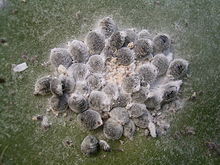Dactylopiidae
| Dactylopius | |
|---|---|
 |
|
| Dactylopius coccus | |
| Scientific classification | |
| Domain: | Eukaryota |
| Kingdom: | Animalia |
| Phylum: | Arthropoda |
| Class: | Insecta |
| Order: | Hemiptera |
| Superfamily: | Coccoidea |
| Family: |
Dactylopiidae Signoret, 1875 |
| Genus: |
Dactylopius Costa, 1835 |
| Species | |
|
11 |
|
11
Dactylopius is a genus of insects in the superfamily Coccoidea, the scale insects. It is the only genus in the family Dactylopiidae. These insects are known commonly as cochineals, a name that also specifically refers to the best-known species, the cochineal (Dactylopius coccus). The cochineal is an insect of economic and historical importance as a main source of the red dye carmine. It has reportedly been used for this purpose in the Americas since the 10th century. Genus Dactylopius is also important because several species have been used as agents of biological pest control, and because several are known as invasive species.
In general, cochineals are waxy gray insects, but the adult females turn bright red when crushed, due to their carminic acid content. Most species are covered in thin, sticky strands of wax; D. coccus lacks these. As in other scales, the tiny males have wings, and the larger females do not.
Cochineals live on cactus plants, especially prickly pears (Opuntia spp.), as well as Cylindropuntia and Grusonia species. One species was collected from Corynopuntia schottii. They gather in large clumps mainly in shady, sheltered areas on the cactus pads and feed on the sap. Some species also infest the cactus fruits, flowers, stems, and roots; they are often found on the roots during times of the year when they are less active. Females have three developmental stages (instars), and males have five. They reproduce continuously year-round, with up to six generations per year. Eggs hatch very soon after they are laid, sometimes within minutes, and probably even occasionally while they are still inside the female.D. tomentosus carries its eggs on its body in a mesh of fibers. The wax filaments are produced from setae on the juvenile insect's head. These webby filaments likely aid in dispersal of the insects by catching the wind.
...
Wikipedia
